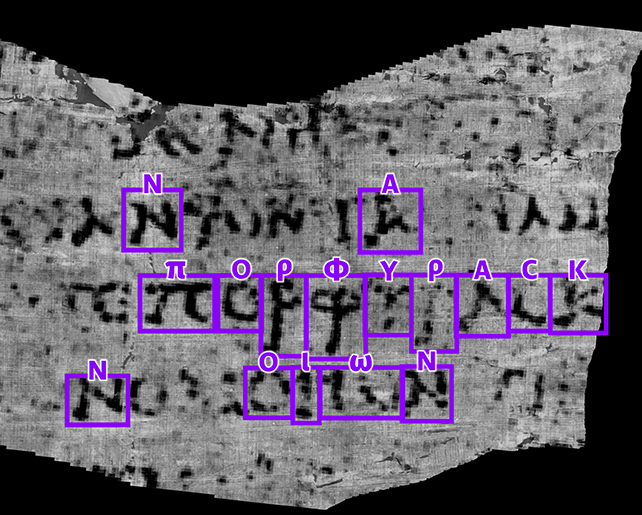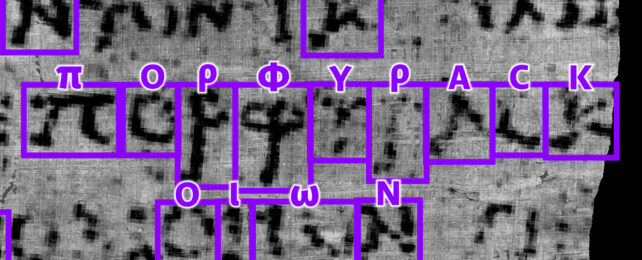As you might imagine for a scroll that has been buried under mounds of volcanic ash from Mount Vesuvius for close to 2,000 years, the rolled-up papyrus excavated from the ancient Roman city of Herculaneum is rather difficult to open, let alone read – but AI has found a way.
Scholars from the University of Kentucky launched the Vesuvius Challenge in March, releasing thousands of X-ray images of charred, carbonized Herculaneum scrolls together with untrained artificial intelligence software that could be used to interpret the scans.
Now two students have claimed the first prizes to be awarded: Luke Farritor, a computer science student at the University of Nebraska-Lincoln, and Youssef Nader, a biorobotics grad student at the Free University of Berlin in Germany.

Both Farritor and Nader independently identified the word "πορϕυρας" (or "porphyras" using modern Greek characters), meaning "purple" – making it the first full word to be decoded from the scripts using the AI software.
In ancient Rome, purple was a significant color, often representing wealth and status. It's thought that the word could refer to robes or to rank, though further analysis of the scrolls will be needed to know for sure.
Farritor trained a machine learning model on a 'crackle' pattern identified on the scroll in August – a pattern that may indicate a stroke of ink. As the AI discovered more crackles and ink strokes, the new training data meant it got better at detecting other patterns, and eventually the word porphyras appeared.
Nader also used a machine learning approach, but trained the AI on shapes in the images that looked as though they might be letters. Again, machine learning – getting the AI to identify new patterns by showing it what those patterns should look like – was able to highlight the word porphyras, as well as some surrounding letters.
With enough training data, these AI engines are able to spot very slight variations in texture in the X-ray images, revealing strokes of ink that aren't visible to the human eye. Researchers are hoping that even more is revealed soon.
The main Vesuvius Challenge prize – with $700,000 attached to it – goes to the person who can read four or more passages from one of these rolled-up scrolls. If you think you've got what it takes to decipher the text, you can even have a go yourself.
Having been buried after Mount Vesuvius, which erupted in 79 CE, these scrolls weren't discovered until the 18th century, when workers came across the remains of a luxury villa – a villa that may have belonged to Lucius Calpurnius Piso Caesoninus, Julius Caesar's father-in-law.
Sadly, very little ancient text like this has survived to the present day. If these scrolls can be read without opening them – which would likely see them crumble to dust – we could unlock an invaluable wealth of information about life and learning in the first century.
